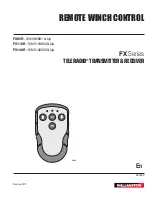
10
CAUTION
Never try to recharge a dry cell battery.
■
The transmitter may be damaged or the bat-
tery electrolyte may leak or the battery may
break.
Insert the batteries in the correct polarity.
■
If the polarity is incorrect, the transmitter may
be damaged.
When the transmitter is not in use, remove
the batteries.
■
If the battery electrolyte leaks, wipe off the
case and contacts.
CAUTION
Do not use commercial AA size NiCd and
NiMH batteries.
■
Quick charging may cause the battery contacts
to overheat and damage the battery holder.
When closing the battery cover, be careful
that the battery cover does not pinch the bat-
tery lead wires.
■
Shorting of the battery lead wires may lead to
fire and abnormal heating and cause burns or
fire disaster.
When using an optional rechargeable battery, replace the battery as
described below.
-The type of power source used must be set by system setting.
-When the transmitter will not be used for a long time, remove the
battery.
Optional battery
NiMH : HT5F1800B
Charge Jack of T3PV is used
After removing the dry
cell battery box from the
transmitter, disconnect the
connector.
Insert the connector of the
new battery and load the new
battery into the transmitter.
Connect the battery
connector
When charging it, LiFe battery
is removed from transmitter.
Balance charging connector for
LiFe battery charger.
LiFe : FT2F1700BV2/FT2F2100BV2
Charge the optional FT2F1700BV2/2100BV2 (LiFe) battery with the special charger in accordance with
the instruction manual supplied.
When the battery will not be used for a long time, to prevent it from deteriorating we recommend that it be
kept in about the half capacity state instead of fully charged. Also be careful that the battery does not enter
the over-discharged state due to self-discharge. Periodically (about every 3 months) charge the battery.
When Using The Optional Battery
Summary of Contents for 3pv-2.4g
Page 1: ...R 1M23N31504 ...









































